As a big fan of the Batman Arkham games, I was heartbroken after playing Suicide Squad: Kill the Justice Leagues alpha test. The shooter component and associated live service model took some time to get used to. In Suicide Squad: Kill the Justice League, heroes are villains and villains are heroes.
Developer Rocksteady set a new standard for licensed games in general and superhero games in particular two console generations ago with Batman: Arkham Asylum. Although Suicide Squad: Kill the Justice League is narratively a continuation of the same Arkhamverse, the British studio takes a radically different approach in terms of content.
The game’s story sets exactly the right tone: light-hearted, funny, a bit crazy, but above all believable. At its strongest moments, it’s reminiscent of James Gunn’s Guardians of the Galaxy films. Brainiac has attacked Metropolis, Superman’s city, and brainwashed some members of the Justice League. Commander Amanda Waller retrieves Deadshot, Harley Quinn, King Shark and Captain Boomerang from Arkham Prison to stop Brainiac. And you guessed it, for that you have to go straight through the Justice League.
Of course, the four psychopaths also have to deal with each other, their erratic leader Waller and her right-hand man Rick Flag. Yes, Kill the Justice League is once again packed with iconic and obscure DC characters, and they are all convincingly portrayed by the voice actors. From Batman (played by the late Kevin Conroy, of course) and Wonder Woman to Riddler and Gizmo, as well as Task Force X itself; the acting is convincing, the chemistry between characters is there and that often creates hilarious scenes.
In between you mainly carry out the same types of missions. For example, there is a mission in which you have to escort a number of people to Toyman’s bus. Sometimes these are Rick Flag’s soldiers, other times Penguin’s henchmen, but the mission itself is exactly the same, except for that cosmetic detail and the location on the map, every time, right down to the animations.
Moreover, it hardly matters whether you have to evacuate people, escort a van, or destroy turrets. Bottom line, Suicide Squad mainly consists of jumping around with everyone’s unique traversal abilities (Deashot uses a jetpack, Boomerang a Speed Force Gauntlet, Harley Quinn takes up Batman’s grappling hook and King Shark can just jump really far.) and shooting at everything that moves.
Let’s be honest: shooting, jumping, flying, pounding, running and swinging goes very smoothly. The four anti-heroes all have slightly different skills, but the controls allow them to operate all four with almost the same speed. As soon as the controls click a bit, the game makes you feel strong and powerful, just like the games with Batman and Spider-Man do. Not an unimportant detail in a superhero (or rather villain?) game.

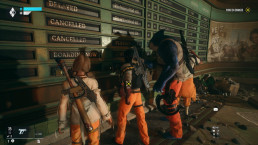
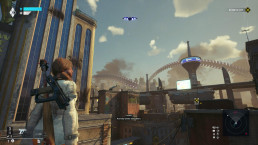
To make Suicide Squad playable for longer – beyond the end of the story – collect new weapons and gear every time. You can then also upgrade and modify that gear. The problem is that none of it really matters.
Your weapons have more stats than necessary, because the only number that matters is how much damage you do per second. Especially in the midst of the chaotic shootings, every gun feels and sounds the same. Side characters whose sole function is to modify those weapons and gear are therefore just as forgettable as Milton.
It’s a shame that your loot still plays such a major role in the game. The cutscenes, for example, are beautiful, well written and also feature excellent voice work. Often a shame is the score screen after a battle, which completely takes you out of the story.
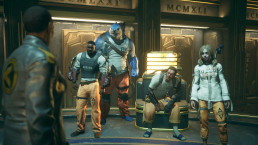
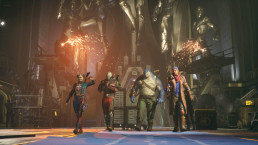
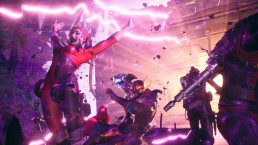
Despite its flaws, Rocksteady still shows at certain moments that it is still a talented studio. The city is beautifully and richly designed, with all kinds of unreal art deco constructions and countless references to the DC universe and all its inhabitants, it is definitely worthwhile to go on a sightseeing tour of the city.
Suicide Squad is also technically well put together. The game looks colorful, sharp and lightning fast. During battles, the frame rate remains quite stable at 60fps, even during the bizarrely chaotic final battle, a feat in itself.
Still, it’s clear that Suicide Squad and Rocksteady are not a happy marriage. The studio’s talent is clearly visible when it comes to the technology, the acrobatic fighting and the voice acting, but the boring missions and meaningless loot make Suicide Squad a mess. After about ten hours, Task Force X’s mission is over. However, Suicide Squad still has all kinds of endgame content to offer and new seasons will be released soon, which will also add other anti-heroes to the game.
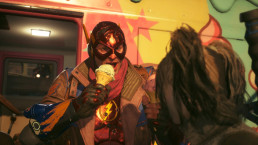
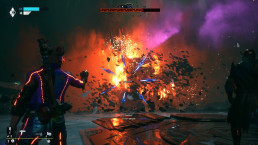

Suicide Squad: Kill the Justice League is available now for PlayStation 5, Xbox Series X and S, and PC. For this review, the game was played on an Xbox Series X.
Score:
0,0
+ High-quality voice acting
+ Fighting feels powerful
+ Stable frame rates under impressive conditions
– Repetitive missions
– Scoring and loot screens are often annoying interruptions